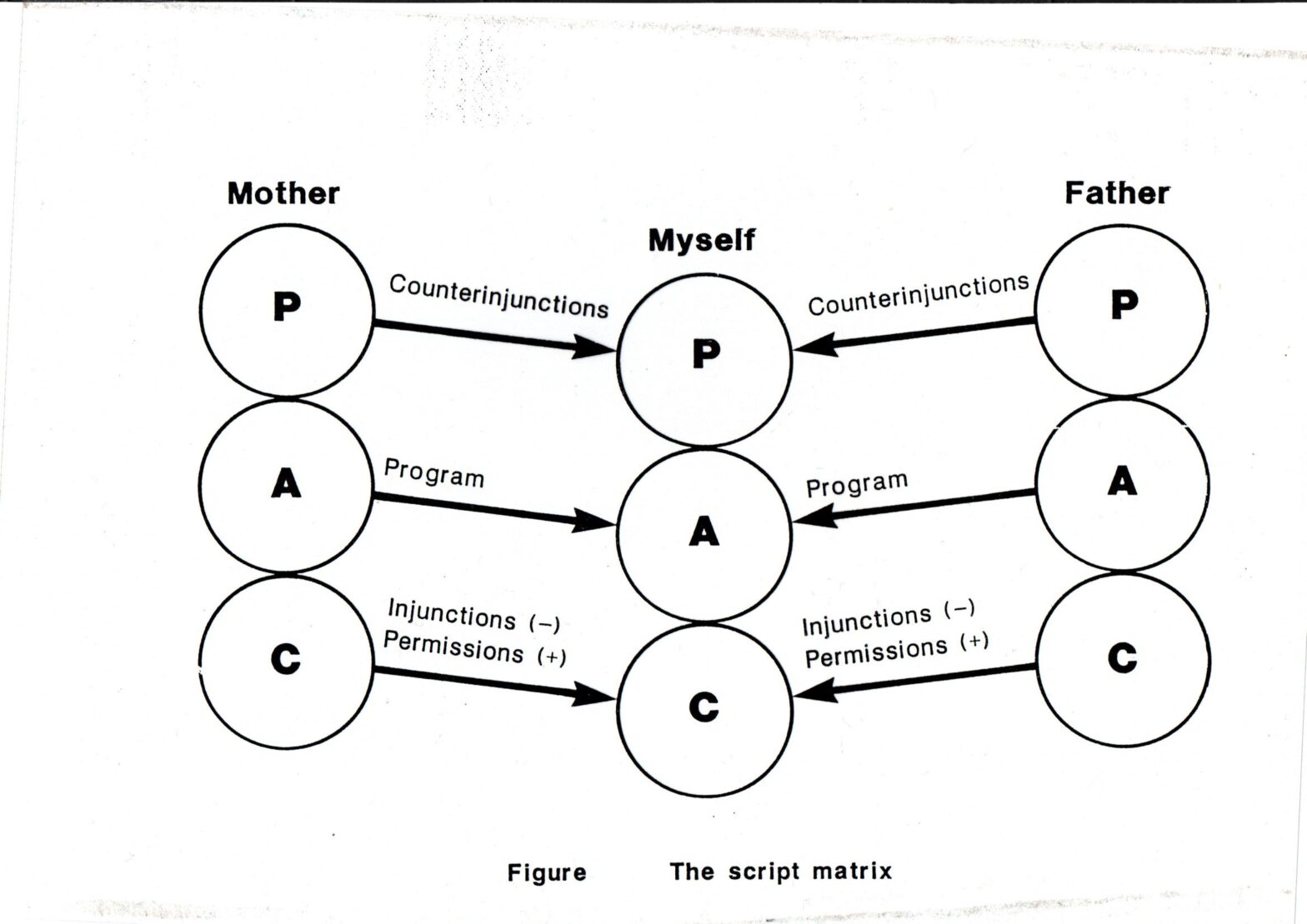This can be a tricky area to visit, as my diagram may well suggest! There is a close relationship between Injunctions, Drivers and the Script, as they are understood within the TA model.
The above picture is intended to demonstrate how two care-takers can impact on the life story I develop as I grow up. You may need to forgive the ‘Mother’ and ‘Father’ labels as the illustration is now many decades old.
My diagram is intended to help understand how ‘old’ influences still impact on today’s relationships. Please think of ‘Injunctions’ as an early childhood message, usually a prohibition, that is reinforced or even contradicted in adolescence by the Drivers or counter-injunctions.
Although the Drivers I identify are a ‘normal’ part of life, some people want to use safe experiments to ‘inoculate’ themselves from some of the adverse impact of Drivers.
Drivers, Stoppers and Allowers
In so doing, we can look our STOPPERS in the eye and foster an ‘ALLOWER‘ instead – that is, the OK-side to Drivers. For instance, my own personal experience was with Be Strong as a TA Driver. It has helped me to stand back and see the larger picture.
At the same time, it made it difficult for me to ask for things from others. This led me into the small, safe experiment of ‘asking for things’.
See further comment on this at the sub-heading Don’t Belong.
By the way, Allowers have been revisited of late by the Tapping School, where you may find discussion of ‘glimmers’. The term, coined by Deb Dana, a US social worker who works with Stephen Porges on the Polyvagal theory. I discuss her work in more detail on this page relating to Shame.
Nick Ortner points our that “glimmers” refer to small moments (small victories) when our biology helps us to connect and regulate our lives; to help our nervous system to feel safe or calm.
TA can add its own dimension by telling us about lessons that can arise from small defeats. Drivers and Scripts can ‘imprison’ us in a particular patterns of behaving. We can ‘break out’ from the ‘prison’ but the key messages are instilled into us during childhood, and reinforced in adolescence. Richard Holloway, a theologian, puts it like this:
Whether or not we acknowledge it, we all live by the stories we tell ourselves to explain the mystery of our existence …. They also supply us with rules for living the lives we have been thrust into.
in the Preface to his book called Stories We Tell Ourselves (2020)
It’s rather handy to have this dilemma reinforced from a non-scientific source!
All these views infer that it is not so easy to make the unconscious, conscious.
I trust this page will cast light on the practical benefits that can emerge from managing the boundaries maybe using such devices as the Johari Window
So, what are ‘Drivers’ as TA sees them?
Take a look at these web-sites, as listed, to read accounts of the Five TA Drivers. That’ll save me having to summarise things here!
……. and you can find a brief account at:
and there is a more detailed, coaching angle at:
I include this last reference as it acknowledges the work of Taibi Kahler, Mavis Klein and Mary Cox. Each one played an important part in developing the TA model (and the last two I remember well from my own training a good few decades ago!).
Some questions to consider
As you look through this material, consider the following questions:
- If Drivers are unconscious motivators, what might I do to identify my own specific Driver behaviour?
- How much of my time is spent being Driven by the five messages, as summarised?
- Does a ‘favourite’ Driver (or two) act as a STOPPER and …..
- ….. how would you prefer it to be in the near future?
- What small safe experiments might help to understand what a Driver is and how I might relate to Drivers differently?
- What are my ‘Allowers’; the antidotes to Drivers? How well do I use them, day-to-day?
All safe experiments are best recorded so the small and subtle results do not get lost. The answers to your questions are important and you may find a need to return to your notes more than once.
So what about ‘Allowers’?
Back to Manchester for some thoughts on that topic.
…. a site with a free guide to TA, if that is of help to you.
The antidotes to consider when designing your safe experiment around Drivers would be to identify how to turn your Driver into your Allower. For instance:
Driver: Hurry Up into Allower: Take Your Time.
Driver: Be Strong into Allower: Be Open And Express Your Wants.
Driver: Be Perfect into Allower: You Are Good Enough As You Are.
Driver: Try Hard into Allower: Just do It a bit at a time.
Driver: Please others into Allower: Please Yourself.
This work can be connected to other small, safe experiments relating to the Stroke Economy
A summary comment
The basic conclusion from this commentary on Drivers, Allowers and the Stroke Economy is that working hard may not ‘bring home the bacon’. Rather like getting stuck in a quagmire on Dartmoor is best managed – not by struggling – but slow and steady movements toward the bank. So it is with Drivers. You can end up working hard to stand still or, even worse, slide under!
‘I’ll be returning to this topic in the future as there is much to be said about our Life “Script” but, above, I starting with my preliminary thoughts and encouragers. My further thoughts will appear in the ‘return’ list of pages at the bottom of this page.
You can help me develop ideas here by focusing on what is relevant to you. Let me know more, here …..
